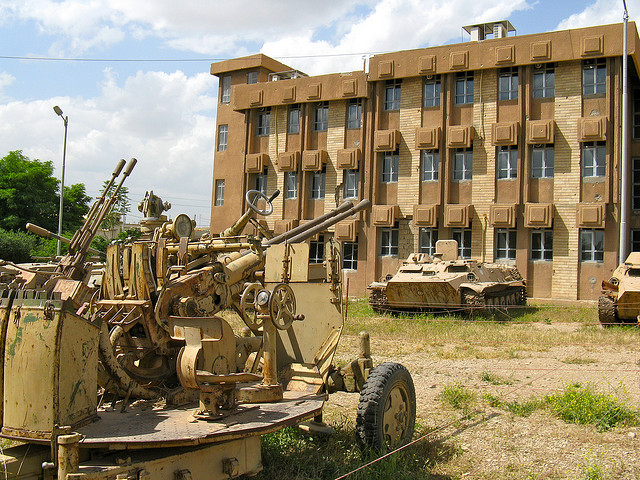When a US military unit visited Diyala prison, north of Baghdad on May 25 2006, it discovered a man who had been held in an underground bunker. He had been tortured for approximately two months.
May 25 2006Related article: Obama administration handed over detainees despite reports of torture
His hands were bound/shackled and he was suspended from the ceiling; the use of blunt objects (pipes) to beat him on the back and legs; and the use of electric drills to bore holes in his legs.
 |
| Iraqi Prison - ChristineK/Flickr |
Abuse and torture
This is just one of 1,365 cases categorised in the military records as potential detainee abuse by Iraqi authorities. The US files, which continue late into 2009, detail torture and clear evidence of widespread mistreatment of detainees. And these are just the cases identified and logged by US troops.
May 3 2009Graphic: detainee abuse in Iraq
A detainee claimed that his interrogators kicked, punched, slapped him on the face, stomach, legs, and also electrocuted his hands, left ear, and genital area for approximately 15-30 minutes. … [the] detainee said that his mouth was covered … because the Americans might hear his screams. Detainee was then taken back to his cell … he fainted and was carried to his bed.
Torture an accepted practice
The war logs show how the use of torture occurred not just in prisons, but army bases and police stations. Rooms were specifically set up for these purposes.
On May 2 2009 US troops found bloodstained instruments in the office of an Iraqi police station chief. He said he was “aware of the beatings and supported it as a method of conducting investigations”.
Related article: US troops ordered not to investigate Iraqi torture
One particular case on June 17 2007 stands out.
June 17 2007 Extensive scars resulted from the chemical/acid burns, which were diagnosed as 3rd degree chemical burns along with skin decay … [the Iraqi army lieutenant colonel] tortured him by pouring chemicals on his hands, cut his fingers off, and hid him when Coalition Forces visited. The Deputy of Police Affairs at the Ministry of Interior (MOI) was informed of this case. The report states: “Warrants were issued on 11 Sep 07 … however no arrests were made. Victim received extensive medical care at the Mosul General Hospital resulting in amputation of his right leg below the knee, several toes on his left foot, as well as amputation of several fingers on both handsHow torture was reported
In another case on October 23 2006, a US army captain conducted a spot-check on an Iraqi Army detainee processing centre in Baghdad. The report describes how he caught Iraqi officers – a captain and a sergeant – in the act.
October 23 2006
There was what appeared to be a battery with open ended wires, the end of a cot with yellow rope on both ends and what appeared to be plastic tubing. Before entering the office [the officers] heard what sounded like an individual being hit, and moaning. The detainee was sitting in the centre of the room sobbing.
Another report recounts how “during the interrogation the Iraqi army officer again in Baghdad attempted to pull one of [the detainee’s] fingernails out with a pair of pliers”.The Bureau of Investigative Journalism is an independent, not-for-profit organisation that carries out research in the public interest. Unless otherwise stated our articles and graphics can be republished without charge. However, there are a few things we ask you to bear in mind:
Many of the cases cite that they were “reported through operational channels as required” by orders issued in 2004 and 2005. While it is not known what happened with the information once reported, the orders state “there is no requirement to investigate”.
Related article: Allegations of prisoner abuse by US troops after Abu Ghraib
Politics of abuse
A pattern emerges in the secret files of the techniques employed in the interrogations. It is not just brutal physical and psychological torture, sexual abuse, rape and sodomy are repeatedly seen.
October 19 2006
The detainee was blindfolded, beaten about the feet and legs with a blunt object, punched in the face and head. Electricity was used on his feet and genitals and he was also sodomised with a water bottle.In the absence of chemical weapons, the British and US governments justified going to war on the grounds of ridding Iraq of the brutal regime of Saddam Hussein. On February 15 2003, Tony Blair said, “There will be no march for the victims of Saddam … no righteous anger over the torture chambers which, if he is left in power, will be left in being.” Clearly ridding Iraq of Saddam did not stop the torture.
- Our material can’t be edited, except to reflect relative changes in time, location and editorial style.
- If republishing online please link to us and include all of the links from our story.
- Our material cannot be sold separately.
- Our material cannot be republished wholesale; selected stories need to be republished individually.
- Photographs and video cannot be republished without specific permission from the licence holder.
- If quoting from our research the Bureau of Investigative Journalism must be credited.
Th Bureau is licenced under Creative Commons, which provides the legal details.
If you have questions, contact us on info@thebureauinvestigates.com or +44 (0) 207 040 0081